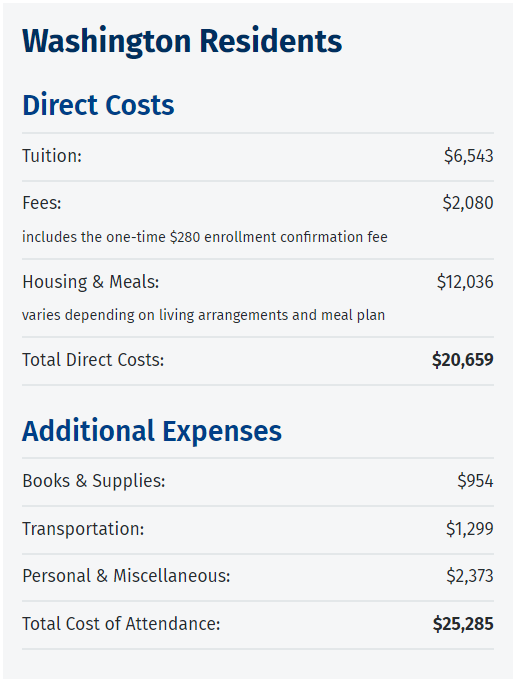As a college student in 2020, there are some hard truths you have to deal with. Everything is expensive (price), everything is cheap (quality), you may not gain any competitive edge over most peers, and ultimately, you (or often your future-self or parents) are seen as merely dollar signs by the institutions that be. Must this be the case? Many others have shone a light on tuition inflation with no noticeable change in the quality of education and they have made those arguments in such a way that for me to interject a half-assed note of agreement might be a disservice to them. I, ultimately, have my own points to raise.
What if students and administration together could solve one aspect of the college price gouging system in such a way that the solution might benefit everyone directly involved?

Part of the college condition is that tuition costs are the tip of the iceberg. The image at right is taken from the Western Washington University (WWU) Website, as I am a current student at WWU and am personally familiar with the fees associated I feel comfortable using them as a model (not to be confused with my previous school Walla Walla University or WWU). Beyond simply tuition, there are roughly $18,000 of added costs per year with a substantial amount of this being housing and dining (something you can avoid if you live close to a university… I do not.) The College Board estimates students will spend roughly $1,240 per year on textbooks, and textbooks are what I would like to address. Is there a way to significantly cut student’s required spending on textbooks, which are currently essential materials for almost every college course? There exist many cost-saving tips for the students who balk at the $200 – $300 price-tag for some required books (especially in STEM fields). Renting, buying used books online, sharing with classmates who have purchased copies, etc. are all fairly common practices. Some students just refuse to buy them and hope it won’t be reflected too much in their final grade. However, none of this changes the fact that publishing companies are able to extort students who do not have access to a competitive market. So, clearly all we have to do is convince the publishing companies to lower prices for the good of students, hooray! While an extremely easy solution, it is also rather unlikely. In fact, the chances that any practical solution will involve publishing companies (or anyone that profits off the rigged market that are college textbooks) are slim to none.
Students spend on average $85 per textbook with some books costing as much as $300 and some as low as $20. Some classes require a textbook as well as several novels, biographies, or other writings. Some teachers use textbooks for assigning homework problems, assigning readings, workbook assignments, etc.
Are textbooks essential?
Ultimately that is up to each individual teacher to decide. Some teachers use textbooks for functional purposes, whether assigning homework or leaning on it for lecture material. Others use it to supplement their own lecture material, and still, others use it only because they feel they should. There are a select few teachers that recognize the effect of the tet book racket on students and build a course without needing a textbook. This is the basis for the following solution.
What if teachers were offered a $20 cash bonus per student for a class without a textbook?
If a teacher were offered $20 cash, per student in a class that does not have a required textbook, would they voluntarily do the work to build a course that could function without a textbook? There are a number of considerations relating to teachers, students, and administration, all of which will be addressed below.
Would the class type/size matter for teachers that took the offer?
Scenario A: Class of 400 students – As it stands, a class of 400 students and a textbook cost of $100, students will collectively spend $40,000, the vast majority of which goes to publishing companies and investors. If the teacher were presented with this offer and accepted they would stand to receive an $8,000 payout. This might result in overall savings to the class of $32,000 and an additional $8,00 to the teacher who would have received nothing from the sale of 40,000 worth of textbooks (assuming they are not the author, in which case the payout might still be less). I believe this teacher would be strongly in favor of this.
Scenario B: Class of 50 students – Now take a class in which the teacher might only receive a $1000 payout. Not quite as tempting as the $8,000 payout given to the teacher in scenario A, however, teachers often teach more than one section of a class per term. A teacher with 2 or even 3 sections of a class with 50 students each might earn as much as $3,000 per term. Perhaps this is not enough… A class built without a textbook can function relatively unchanged for a very long time. If it took a teacher 40 hours to develop the materials necessary to ditch the textbook they could easily calculate the hourly payout of that work. Even if that by itself was not enough the added incentive of additional payouts each time they teach that class with previously developed course work. I believe this teacher would be moderately in favor of this.
Scenario C: Class of 20 students or fewer – The scenario that offers a teacher the least incentive (on face value) is a class that has very few students. On the financial side, the teacher would be offered a maximum of $400 to make the necessary adjustments to the course. However, this may be offset by the practical functioning of a class this size. While a teacher may not want to invest time and energy into developing a course that would not need a textbook, this teacher is best suited to create a learning environment based on communication and question answering rather than a “learn from a book” model.
Textbook Non Requisitus
Most students will take 4 or 5 courses per term for 12 quarters or roughly 54 classes over a college career. With an average cost of $100 per textbook, the average student might spend $5,400 on books alone. If every teacher moved to this model, the cost to students for the same 54 classes would drop to $1,080, or a savings of 80%. Or with the more conservative estimate published by the college board of $1,240 per year or $4,800 it might still result in a 77.5% reduction in the total textbook cost.
Even if the emergence of e-books accelerates (average cost $60 or $3,240) it would still result in a 66% savings for students.
I will be exploring the following two ideas in the near future. Stay Tuned!
Who is loosing out?
Implementation
In the meantime, if you know a student at WWU please ask them to fill out the following survey.

